The United States Constitution Series
The Bill of Rightslimited edition set
An Edition of 25 Copies of a Set of Ten Works by Richard Minsky
Since 1993 Richard Minsky has been working on a series about The Bill of Rights. The current offering is a set of ten bookworks.
The works are not available individually.
An exhibition of the complete set was installed at the Louis K. Meisel Gallery April 27 through June 1, 2002.
The earlier unique objects, representing the first, second, and eighth amendments, are on this website. When viewing them, please keep in mind that they are not the works which will be included in this edition.
Congress shall make no law respecting an establishment of religion, or prohibiting the free exercise thereof; or abridging the freedom of speech, or of the press; or the right of the people peaceably to assemble, and to petition the government for a redress of grievances.
Issued February 19, 2001
The First Amendment
Reliquary for the Ashes of Salman Rushdie's Satanic Verses.
Upon publication the author lost the freedoms of Press, Religion, Speech and Assembly in some countries. The Fatwah issued on Rushdie, and the book-burnings made headlines around the world.
The fact that an ancient form of censorship exists in the 21st century warrants the inclusion of this book in the series. Not the book-burning kit of the earlier unique work, this is a new book-shaped reliquary containing the burned book. Click the burning book for another view. The book was burned on 01/01/01. On the left is the book after the burning, before being placed in the reliquary.
Amendment IIA well regulated militia, being necessary to the security of a free state, the right of the people to keep and bear arms, shall not be infringed.
Amendment III
Issued April 22, 2002
The Second Amendment
Gathering Storm: America's Militia Threat
by Morris Dees with James Corcoran
Morris Dees is the Chief Trial Counsel of the Southern Poverty Law Center. This book documents the hate group roots of the militia movement. Dees is intimately familiar with the players. Militia spokesman and former Ku Klux Klan Grand Dragon Louis Beam was prosecuted by Dees when he led the KKK intimidation of Vietnamese fishermen in Texas. Dees' office was firebombed, and his commitment to freedom has made him a target of racist assassins. The front endpaper (detail, left: inkjet and gold leaf on Rives BFK) is an image of the author as a target. The halo is gold leaf, as in medieval and Renaissance icons.
This book has a substantial photo section which includes William Pierce, leader of the racist National Alliance and author of the 1978 novel The Turner Diaries (which tells the "history" of the successful Aryan Revolution and is believed to be the manual used by Timothy McVeigh in planning the Oklahoma City bombing). Other detailed players with photos are John Trochmann, founder of the Militia of Montana and Christian Identity's Pete Peters, whose followers include the Army of Israel militia. This sect believes the Aryans are the true Jews and the people who call themselves Jews are literally descended from Satan. They consider this a Holy War.
The Militia movement in the United States expanded dramatically in the mid 1990's. Spurred by the Randy Weaver incident at Ruby Ridge and the catastrophe at Waco, fear of government abuse led to militia organizations in every State. Many militias then broke into small cells of about five members, a strategy followed by the Al Quaeda network.
Current reports on hate groups and militias are online at the Southern Poverty Law Center.
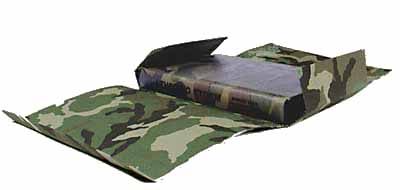
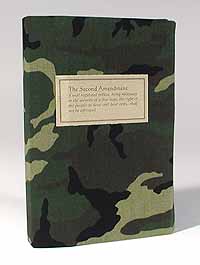
The binding is camouflage leather foil stamped in black with quotes from the text on the front and back covers. The protective enclosure is camouflage cotton cloth with the text of the second amendment printed inkjet on khaki cloth.
No soldier shall, in time of peace be quartered in any house, without the consent of the owner, nor in time of war, but in a manner to be prescribed by law.
Amendment IVThe right of the people to be secure in their persons, houses, papers, and effects, against unreasonable searches and seizures, shall not be violated, and no warrants shall issue, but upon probable cause, supported by oath or affirmation, and particularly describing the place to be searched, and the persons or things to be seized.
Issued March 13, 2002
The Fourth Amendment
Neuromancer
by William GibsonThe novel that introduced us to Cyberspace. Every day there are more issues about government searches of our emails, web habits, and hard drives. You can read about the implications at The Electronic Frontier Foundation and Quest of the Unquietmind.
The book was originally issued as a paperback in 1984 and received major awards for science fiction writing. The binding is in limp black leather, to preserve the soft feel of the paperback. A shuriken (Ninja throwing star) is on the cover, and is an image that appears throughout the text. The pink slipcase has the text of the fourth amendment hot-stamped in hologram foil on one side. The hologram makes the text appear as colored digital code from a distance.
On the other side of the case (Case is also the name of the protagonist) is an embedded Network Interface Card. In the novel, Case jacks into the cyberspace network through a neural interface.
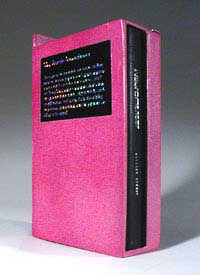
Click on any photo to see larger images and more views.
Amendment VNo person shall be held to answer for a capital, or otherwise infamous crime, unless on a presentment or indictment of a grand jury, except in cases arising in the land or naval forces, or in the militia, when in actual service in time of war or public danger; nor shall any person be subject for the same offense to be twice put in jeopardy of life or limb; nor shall be compelled in any criminal case to be a witness against himself, nor be deprived of life, liberty, or property, without due process of law; nor shall private property be taken for public use, without just compensation.
Amendment VI
Issued May 24, 2000
The Fifth Amendment
BRANCHES
by Mitch Cullin
illustrated by Ryuzo KikushimaWritten in the first person as the story of a Sheriff in Texas who is judge, jury and executioner.
The Bill of Rights edition is a deluxe boxed version of the limited edition created for the publisher. Each copy of the book has 9mm bullet holes shot through the cover, a Sheriff badge, and the title is affixed as a name badge. This edition of Branches includes color prints of the 16 illustrations, tipped in over the black and white reproductions in the book. You can also see more details of the binding and illustrations.
The Fifth Amendment version of this edition is available only to the subscribers of The Bill of Rights series, and includes a box made of the same uniform fabric as the book, with a black leather holster bearing the foil stamped text of The Fifth Amendment sewn to the cover.
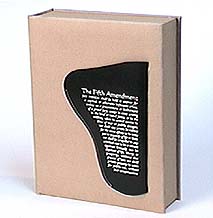
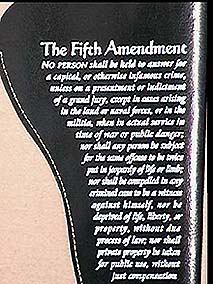
In all criminal prosecutions, the accused shall enjoy the right to a speedy and public trial, by an impartial jury of the state and district wherein the crime shall have been committed, which district shall have been previously ascertained by law, and to be informed of the nature and cause of the accusation; to be confronted with the witnesses against him; to have compulsory process for obtaining witnesses in his favor, and to have the assistance of counsel for his defense.
Amendment VIIIn suits at common law, where the value in controversy shall exceed twenty dollars, the right of trial by jury shall be preserved, and no fact tried by a jury, shall be otherwise reexamined in any court of the United States, than according to the rules of the common law.
Issued April 10, 2002
The Seventh Amendment
The Litigation Explosion:
What Happened When America Unleashed the Lawsuit
by Walter K. OlsonIn 1789 twenty dollars went a long way. Since the 1970's "civil" lawsuits have flooded the judicial system. Now a multibillion dollar business, the litigation industry proceeds on flimsy pretexts, preceding a search for evidence.
The spine of the binding is gold leather with the title foil stamped in silver (neither is the genuine metal). The gold and silver make it hard to decipher. The covers appear to be a collage of $20 bills, but closer examination reveals them to be artificial as well. Jackson has been replaced by James Madison, whose signature replaces that of the Secretary of the Treasury, and whose title reads Father of the Bill of Rights. The text of the Seventh Amendment is superimposed on the treasury seal, and there are several other changes.
The slipcase is covered with court calendar listings from the New York Law Journal. On any day you may find 20 broadside pages listing lawsuits in New York. It is coated with two layers of ultraviolet filter acrylic.
Below: Three details of the cover art.
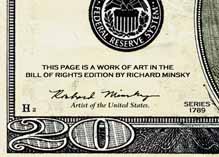
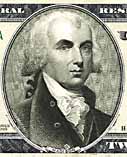
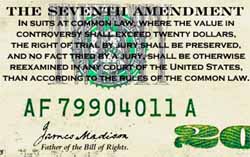
Amendment VIII
Excessive bail shall not be required, nor excessive fines imposed, nor cruel and unusual punishments inflicted.
Amendment IX
The enumeration in the Constitution, of certain rights, shall not be construed to deny or disparage others retained by the people.
Amendment X
Issued October 15, 2000
The Ninth Amendment
The Right to Privacy
by Ellen Alderman and
Caroline Kennedy.
We all assume we have a right to privacy, but every day that right seems to diminish.
From our personal data on the internet to telemarketing at dinnertime, we are barraged. And that's just the tip of it. This book identifies many serious legal issues surrounding privacy considerations.
When people become public figures the violation of privacy becomes extreme. Occasionally those of us not in the public eye are reminded just how dangerous and invasive the thirst for vicarious living can be. The binding is an inkjet print on canvas of Princess Diana, with tabloid headlines on the back cover and endpapers with photos of her wrecked car. It comes in a velour lined black cloth box with the text of the ninth amendment printed on a Fabriano Roma label.
If you want to read the book, click to order The Right to Privacy online as a paperback. This link also will bring up other books on the privacy issue.
The powers not delegated to the United States by the Constitution, nor prohibited by it to the states, are reserved to the states respectively, or to the people.
Click here for links to educational and other resources about the Bill of Rights
The
Bill of Rights edition is in the permanent collections of
Yale
University Arts of the Book Collection
The
Art Institute of Chicago Ryerson & Burnham Libraries
Click
the links above to make an appointment to view this work.
Read the review in The New York Times
click
here to order a set
click here to schedule an exhibition
To continue touring the exhibition:
Each section has several thumbnail images and descriptions of the works. You can click on any image for a page about that work, with larger pictures and details. There are buttons below for other areas of the website.
Section A Bindings 1968-79
Section B Bindings 1979-85
Section C Bindings 1986-88
Section D Sculptural Bookworks from 1988
Section E Bindings 1988-94
Section F Painted Car, Watercolor studies, Bindings
Section G The Bill of Rights, 1993-
Section H Bindings on books by Erica Jong






©2001 Richard Minsky